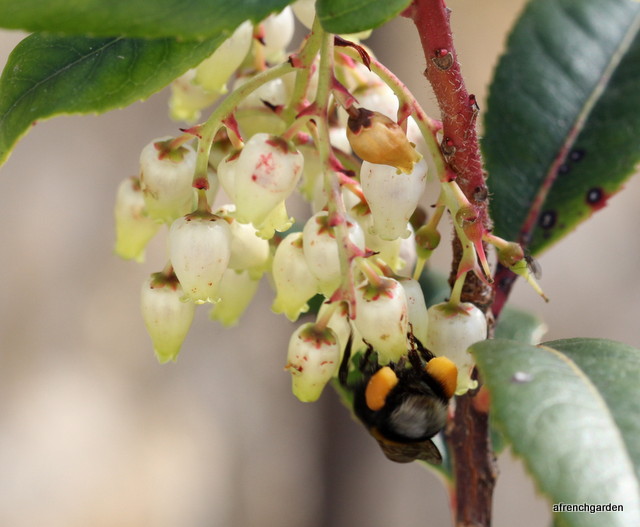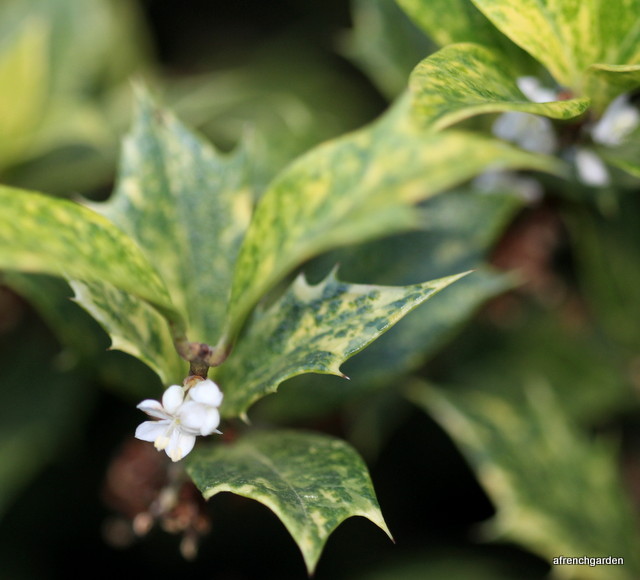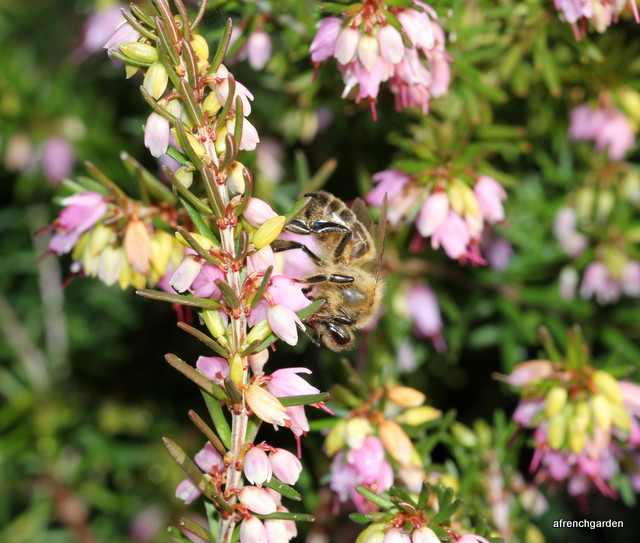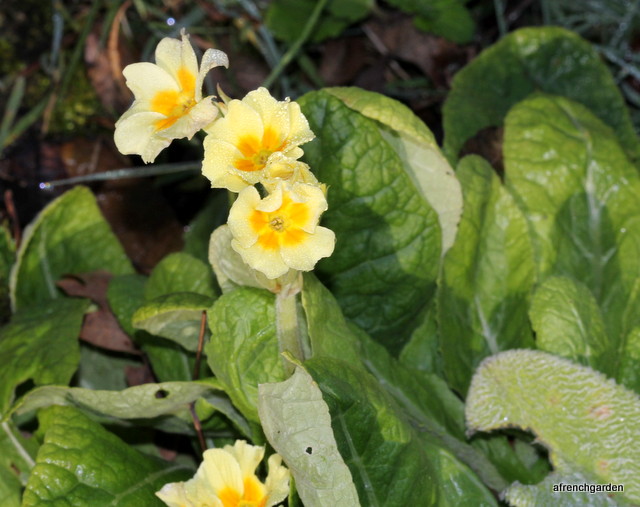When the sun plays on the Loquat (Eriobotrya japonica) tree the perfume expands over the garden and the bees descend on the flowers. The flowers are just starting to open and are only opening slowly.
Have you ever been caught out by thinking an artificial plant was a real one? There are some fake plants that, well placed in a shady corner of a restaurant or hotel, have had me deceived. However, when I look at the Loquat I find that the fluffy stems that support the flowers look more as if they have been fabricated from a soft, synthetic velvet rather having grown in such perfection. The leaves, on closer inspection, are a bit suspect too. Rather too thick and shiny.
The most unusual is the perfume. Extremely pleasant as it is, I find it reminds me of baby talcum powder and not of any other flower that I know! It almost seems as if it is a real plant pretending to be artificial!
We are too far north for the tree to produce its delicious fruit but it is H3 hardy so suitable as decoration in areas with a mild winter.
The Elaeagnus x ebbingei is still flowering. I must try and note next year how long its perfumed season lasts. I am growing this as a screen between the us and the neighbouring garden. It is very amenable to being cut and I like to let it have a free form to give access to the birds and bees but it takes well to being pruned.
The winter honeysuckle (Lonicera fragrantissima) is H6 so we are looking at a plant that will take very cold winters but reward you with flowers and perfume when there is some sunshine and warmth.
The honeysuckle is frequently visited throughout the winter by the buff tailed bumble bee (just to confuse me the buff tailed bumble bees have white tails in France) but I noticed this carder bee on the honeysuckle. It interested me as it is a queen carder that I frequently see in springtime here.
It has a thick brown band at the top of its thorax and I had straight away thought of the brown-banded bumble bee (Bombus humilis) however, it does not match the description of Steven Falk. I then checked on Atlas Hymenoptera – Les bourdons de la Belgique and I think I have found my carder bee as one of the three types that used to be found in Belgium although now they have practically disappeared.
Perhaps I should post this on my other site Bees in a French Garden to see if anyone can help me here. But whatever their names are it is nice to see them in December.
You can tell that the bumble bees are finding plenty of pollen and so must still have a nest with young that they are feeding. The young queens only need nectar to survive until they decide to make a nest. The strawberry tree (Arbutus unedo) H5 is a real hardy tree and the flowers are very attractive, if low on the perfume stakes.
Another white, perfumed flower still blossoming is the Osmanthus heterophyllus “Goshiki”, I should really take a cutting to see if I could start another plant but this one is shaded by a wall and I am not sure whether it would stand the summer sun.
It seems that most of my very fragrant winter flowers are white but now I have the Mahonias I love the splashes of yellow that they are providing. “Charity” is the most prolific but the two “Media” are close behind.
The Anisodontea el rayo continues to flower and attract the bees but now some of the leaves have taken on a copper tint. When I first saw the colour change after some cold nights I thought that was the end of the flowering season but the buds were unaffected and went on to open and flower.
I tend to forget the heather. I am still surprised that it does so well as I had got it into my head that I would not be able to grow heather in my chalky soil. However, the E. x darleyensis varieties that I have survive very well but I could use them more effectively but I am not sure how. Any good placement ideas that have worked for you?
For colour, if not for perfume, the cotoneasters brighten up the garden in all weathers. A seasonal picture to wish everyone a happy Christmas.
Even if you feel more like these primroses that have popped up as if to say “Is it spring yet?”













Wow. You still have blossoms in your garden. What region do you live in? We are covered in snow here in Ontario.
LikeLiked by 2 people
We are just north of Bordeaux, not far from the Atlantic and receive a very temperate climate. Never the less it is exceptionally mild this year. Amelia
LikeLiked by 2 people
It sounds like a kind region in terms of weather. Especially for gardeners and beekeepers like you two. After all these years, I still can’t believe how cold our weather in S. Ontario can get in winter. But this summer was very kind.
LikeLiked by 1 person
Looking out at fields of icy white, I am envious of your December blooms.
LikeLiked by 1 person
It is a while since I have seen fields of white as we do not always get heavy snow even in a U.K. winter. As a child I looked forward to having snow for sledging, I did not think over much of flowers. Amelia
LikeLiked by 2 people
Winter has settled on us officially now. Another five inches last night, two more expected tonight. From here, until about the end of January, we can expect some nearly every day. Our bees are bundled and insulated, like us, dreaming of spring.
LikeLiked by 2 people
Your Carder Bumble keys to B. pascuorum from what I can see in the photo — 1. May have black hairs on abdomen and thorax (the photo shows some black hairs on both); 2. some black hairs on abdominal segments 1-5; 3. Hairs on ventral surface not all or mostly black. Also the long hairs on the hind metatarsus appear to be black.
LikeLiked by 1 person
Thanks for checking things out. What did you think of the three humilis in the Les Bourdons de Belgique? Amelia
LikeLiked by 1 person
I’m not sure what you mean by ‘what do you think of the three B. humilis in the Bourdons de Belgique’? Mainly I thought ‘hmmm tricky little blighters’, but I knew that already. Where I lived in the UK we had all three carders on the saltmarshes, and I knew people who could identify them just by the pitch of their buzz!
LikeLike
Now there’s a challenge for me!
LikeLike
I forgot to say, they will fly into November in a normal year, so in an abnormal year like this, I have no problem with B. pascuorum in December.
LikeLiked by 1 person
It is not so much the time, as the queens will come out in warm periods, I am confused by the variety in colouration. Ameia
LikeLiked by 1 person
Thanks for the report on your garden. You have so much more in bloom than we do now. I wish you a wonderful Christmas and a prosperous (i.e., lots of honey) New year.
LikeLiked by 1 person
Thank you, I wish you a happy Christmas with lots of beautiful plants and weak straggly weeds that pull out easily. Amelia
LikeLiked by 1 person
Good Morning from a cold Vancouver BC. It was -18C on the wall of our garden shed this morning. I cannot imagine our bees will survive this cold weather. Snow expected tomorrow.
We are zone 9A and our Arbutus Unedo thrives on the water side of the house where bitter winds blow from the east.
The only thing blooming is the winter jasmine. The Anna’s hummingbird appreciates it as well as the feeder we keep for them.
Regards and thank you for posting a breath of sunshine in the flowers.
Janine
LikeLiked by 1 person
I’ve never lived in such a cold area. I hope your bees are fine because I know they are very resilient. I have read about new types of insulated beehives which the bees take to very well. It may be worth considering those.
I admire the Arbutus unedo even more now knowing that yours can survive your temperatures! Amelia
LikeLike
You’re so lucky to have a winter garden. There is no such thing here.
LikeLiked by 1 person
I appreciate the mild climate here and I enjoy sharing your ice and snow from afar. Amelia
LikeLiked by 1 person
I’ve said this before, but it’s just amazing what a wonderful climate you have there that produces such beauty in the dead of winter. We’re into the white, gray, and brown phase of winter here in the Minnesota “garden”, so it’s a treat to look at someone else’s colorful garden.
LikeLiked by 1 person
Thank you, we do appreciate this special micro climate in this area and we are just starting to learn what does best here. Amelia
LikeLike
I’m amazed that there are still bees about where you are. I miss my fluffy little friends, especially as there are a number of blooms for them to feed from still. The primroses aren’t quite out and I haven’t checked on the heather (it had been smothered by still blooming borage) but I’m amazed myself at how much is alive and well at this time of the year.
LikeLiked by 2 people
I’d recommend a Mahonia or a winter flowering honeysuckle (this is a bush type and not invasive) and I am sure you will have some company. Amelia
LikeLike
Thank you for the recommendations? How would these fair without direct sunlight for a few weeks in mid-winter?
LikeLike
Mahonia does very well without direct sun and mine are in the shade of trees in the summer but they do very well in the U.K. I saw the bumblebees on the Mahonia in the Saville Gardens in January. The honeysuckle might flower less but it is not always sunny here :).
LikeLike
Okay… I will look into Mahonia and winter-flowering honeysuckle. I have a spot in the front garden which is waiting to be filled 😊
LikeLike
The Mahonia might grow eventually to 4m and has prickly leaves, something to consider if you would have to pass it frequently. The Lonicera fragrantissima wiould only get to 2m. and is very easy to trim and keep in shape, so it depends on the size and placement of you spot 🙂
LikeLike
That’s good to know – it would be close to my neighbour’s lawn and she might not appreciate getting prickled. The Lonicera sounds a better option therefore 😊.
LikeLiked by 1 person
Is if Spring yet, ha I’m with the the primroses! Lovely selection you are sharing with the bees
LikeLiked by 1 person
Thank you but today is definitely winter. Amelia
LikeLike
So that’s how to spell Elaeagnus! Happy holidays (as we must say), Amelia. RH
LikeLiked by 1 person
Are you trying to be politically correct? Amelia
LikeLike
Not really. Just going with the flow…
LikeLiked by 1 person
The medium tree-like mahonia are putting on a good show at present and I saw terrestris workers yesterday on a mahonia in Totnes. Kevin Thomas in Falmouth is reporting hortorum as well as terrestris on mahonia.
LikeLiked by 1 person
That is very interesting. I’ll keep my eye out but I have not seen a hortorum, their queens are so big you cannot miss them. They always make me laugh in the springtime, the ultimate bumble-bee. Amelia
LikeLiked by 1 person
We love loquats and so do the birds and the bats! They have such beautiful shiny brown seeds and their flesh is quite delicious! Winter Honeysuckle is another favourite and is such a long-lasting and generous flowering shrub! Superb photos as always! Wishing you a very Happy Christmas and 2017! x
LikeLiked by 1 person
You are so lucky to have some fruit. We will have to be content with just the flowers as it is not warm enough to bring the fruit to maturation. I do love them as fruit too. Amelia
LikeLike
We are, though the flying foxes ate most of them this year!
LikeLike
I’ve a very soft spots for bats but I think I might draw the line at them eating all my loquats 😉 Amelia
LikeLike
Still honeybees on mahonias here, Amelia. Shouldn’t the workers have been killed off by the very hard frosts we had a couple of weeks ago? Whatever, it was a pleasure to see and hear them. Dave
LikeLiked by 1 person
B. terrestris, the buff tailed bumble bee nests under ground and seems to be able to carry on through southern England winter conditions where there is sufficient forage available. It is so good to hear them on warmer sunny days. Amelia
LikeLiked by 1 person
Ah, OK. I was pretty certain that they were honeybees but admit to not looking too closely!
LikeLike
Sorry I did not read what you wrote correctly. Honeybees will not be killed off by a hard frost. They can live quite happily up a mountain either naturally inside a tree (eg) or inside their hive covered in snow. They survive all through the winter even for months keeping warm in a huddle and eating their stored honey. So seeing honey bees is less surprising than seeing say bumble bees. In cold climates it is only the fertilised young queen bumble bee that survives by hibernating until spring.
LikeLike
I’m obviously having a senior moment. I knew that honeybee workers can survive the winter as we had a bee colony in a chimney. Can’t imagine what I was talking about. Over-excited at Christmas, maybe!
LikeLiked by 1 person